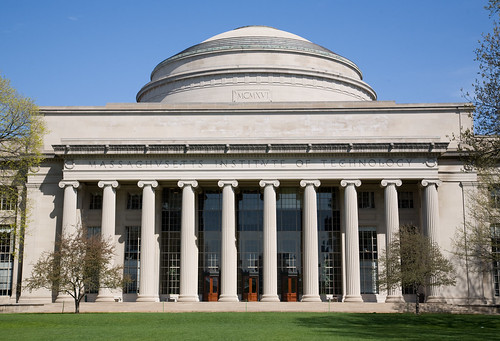
Institut Teknologi Massachusetts (
Massachusetts Institute of Technology atau
MIT), adalah institusi riset swasta dan universitas yang terletak di kota Cambridge, Massachusetts tepat di seberang Sungai Charles dari distrik Back Bay di Boston, Amerika Serikat. MIT memiliki 5 sekolah dan satu kolese, mencakup 32 departemen yang mengkhususkan diri pada sains dan penelitian teknologi.
Didirikan tahun 1861 sebagai respon atas kemajuan teknologi dan industri di Amerika pada saat itu, universitas ini mengadopsi universitas riset ala Eropa. MIT sekarang berdiri di atas tanah seluas 168 are yang dibuka 1916. Dalam kurun waktu 60 tahun belakangan ini, MIT telah mengembangkan cabang lain sepertimanajemen, ekonomi, manajemen, ilmu politik, dan biologi. Departemen dan sekolah yang paling terkenal adalah Lincoln Laboratory, Computer Science and Artificial Intelligence Laboratory, Media Lab, Whitehead Institute dan Sloan School of Management. 59 dari anggota dari komunitas MIT telah memenangkan Penghargaan Nobel. Untuk tahun ajaran 2009-2010, MIT memiliki 4,232 mahasiswa sarjana dan 6,152 mahasiswa pascasarjana.
2. Harvard University

Universitas Harvard (Harvard University) adalah universitas swasta di Cambridge, Massachusetts, Amerika Serikat dan anggota Ivy Leaguedan merupakan universitas terbaik dunia. Universitas ini didirikan pada 8 September 1636 dan merupakan perguruan tinggi tertua di Amerika Serikat. Awalnya bernama New College, dan dinamakan ulang menjadi
Harvard College pada 13 Maret 1639 untuk menghormati penyumbang terbesarnya, John Harvard, seorang mantan mahasiswa Universitas Cambridge. Rujukan terawal yang memanggil Harvard sebagai “universitas” dan bukan “college” terjadi pada tahun 1780.
Universitas Harvard adalah salah satu universitas paling bergengsi di dunia dan mempunyai pendapatan terbesar di antara universitas-universitas di seluruh dunia (US$22,6 miliar pada tahun 2004), hampir dua kali lipat Universitas Yale, pesaing terdekatnya). Rangking universitas Amerika Serikat keluaran
US News tahun 2005 menempatkan Universitas Harvard dan Universitas Princeton bersama-sama di urutan pertama. Universitas Harvard juga meraih urutan pertama pada tahun 2004, setelah lima tahun di posisi kedua dan ketiga.
Times Higher Education Supplement World University Rankings juga menempatkan Universitas Harvard di urutan pertama
3. Stanford University

Leland Stanford Junior University, yang lazim dikenal sebagai Universitas Stanford adalah sebuah universitas swasta yang terletak kira-kira 60 kilometer di tenggara San Francisco dan kira-kira 30 km di timur laut San Jose di wilayah Kabupaten Santa Clara yang belum diresmikan sebagai kota. Stanford terletak dekat kota Palo Alto, California, Amerika Serikat tepat di jantung Lembah Silikon baik secara geografis maupun historis.
Universitas Stanford terletak di kampus universitas kedua terbesar di dunia, dan terdiri atas Sekolah Teknik, Hukum, Kedokteran, Pendidikan, Bisnis, Ilmu bumi, dan Humaniora serta Sains. Universitas ini mempunyai sejumlah program dan sebuah rumah sakit pendidikan selain berbagai kegiatan menjangkau ke masyarakat dan inisiatif relawan.
4. University of California Berkeley

Universitas California, Berkeley (juga dikenal sebagai Cal, UC Berkeley, The University of California, atau Berkeley) adalah sebuah universitas publik yang terletak di timur Teluk San Francisco di Berkeley, California, Amerika Serikat, mengarah ke Golden Gate. Kampus tertua dan “flagship” dari Sistem Universitas California, Berkeley merupakan pemimpin universitas riset. Program “induk”-nya dan profesor-profesornya terus-menerus berada di urutan atas di dunia.
Didirikan pada 1868, Berkeley menikmati zaman emas ilmu fisika, kimia, dan biologi pada awal 1900-an, memimpin pengembangan cyclotron pertama oleh Ernest O. Lawrence, isolasi virus polio manusia, dan penemuan banyak unsur kimia, termasuk plutonium, berkelium, dan californium. Penghargaan Nobel telah diberikan kepada 19 profesornya yang masih aktif sekarang dan di masa lalu kepada 53 orang yang berhubungan dengan universitas ini.
Pada 1960-an kampus ini terkenal ke seluruh dunia dengan lahirnya Gerakan Kebebasan Berbicara dari protes para murid menentang keterlibatan Amerika Serikat dalam Perang Vietnam, secara nyata menjadi bagian Amerika pada 1960-an. Perkembangan berikut termasuk beberapa teknologi kunci berhubungan dengan perkembangan internet, BSD Unix, dan Gerakan Sumber Perangkat lunak Terbuka.
5. Cornell University

Cornell University terletak di Ithaca , New York , Amerika Serikat. Didirikan pada tahun 1865 oleh Ezra Cornell dan Andrew Dickson White , universitas ini bertujuan untuk mengajar dan memberikan kontribusi dalam semua bidang pengetahuan dari klasik ke ilmu dan dari teori terapan. Cita-cita, tidak konvensional untuk saat ini, ditangkap di’s moto Cornell, tahun 1.865 Ezra Cornell kutipan: “akan menemukan sebuah lembaga mana pun dapat orang menemukan instruksi dalam setiap. Studi saya” Sejak didirikan, Cornell juga menjadi pengajar yang non sektarianinstitusi terlepas dari agama atau ras. Cornell menawarkan program dalam seni liberal , teknik , pertanian , manajemen , hukum , kedokteran dan kedokteran hewan . Universitas ini secara luas disusun dalam tujuh sarjana perguruan tinggi dan tujuh lulus divisi di kampus utama Ithaca, dengan masing-masing perguruan tinggi dan pembagian mendefinisikan standar masuk sendiri dan program akademik di otonomi dekat. Universitas ini juga mengelola medis satelit kampus dua, satu di New York City dan satu di Kota Pendidikan , Qatar . Cornell adalah salah satu dari dua swasta universitas hibah , dan tujuh perguruan tinggi sarjana meliputi empat negara yang didukung atau kontrak perguruan tinggi hukum . Universitas ini juga mengoperasikan ekstensi koperasi outreach program di setiap kabupaten kota New York.
Cornell mempunyai lebih dari 255.000 alumni , 31 Marshall Scholars , 28 Rhodes Scholars dan 41 peraih Nobel yang berafiliasi dengan universitas. Jumlah siswa terdiri dari lebih dari 13.000 sarjana dan 6.000 mahasiswa pascasarjana dari seluruh 50 negara bagian dan 122 negara
6. University of Wisconsin Madison
Universitas Wisconsin–Madison adalah universitas riset negeri Amerika Serikat yang terletak di Madison, Wisconsin. alam hal pencapaian dan prestasi, Universitas Wisconsin–Madison telah lama dikenal sebagai salah satu universitas unggulan Amerika Serikat. Banyak program universitas ini yang dianggap sebagai pemimpin dunia dalam hal instruksi, penelitian, dan jasa publik. US News and World Report pada tahun 2006 mencantumkan Universitas Wisconsin–Madison sebagai universitas negeri terbaik Amerika Serikat ke-7.
Universitas ini didirikan pada tahun 1848, dan merupakan universitas terbesar di negara bagian Wisconsin, dengan lebih dari 41.000 mahasiswa, dan 29.000 diantaranya merupakan sarjana. elain nama resminya, Universitas Wisconsin–Madison, universitas ini juga dikenal dengan nama UW–Madison, Madison, Wisconsin, Universitas Wisconsin atau UW.
7. University of Michigan
Universitas Negeri Michigan terletak di East Lansing di sisi Sungai Red Cedar, dan terdiri dari 5.200 acre (21 km²), 2000 acre (8km²) yang telah dikembangkan. Ada 676 bangunan: 203 untuk pendidikan, 154 untuk agrikultur, 245 untuk perumahan dan penyediaan makanan, dan juga 74 bangunan lainnya. Keseluruhan, universitas ini memiliki tempat dalam ruangan seluas 21.931.085 kaki persegi (2.037.464,5 m²). esarnya kampus ini, digabungkan dengan banyaknya pepohonan dan kurangnya lapangan yang terpusat membuat kampus ini indah dan juga sulit dinavigasi.
8. University of Minnesota
University of Minnesota adalah sebuah universitas riset publik yang terletak di Minneapolis dan St Paul , Minnesota , United States . Paul , Minnesota , Amerika Serikat . Universitas adalah bagian terbesar dan tertua dari University of Minnesota. Memiliki jumlah mahasiswa terbesar ke empat di Amerika dengan jumlah dengan 51721 siswa di 2010-2011. University of Minnesota adalah peringkat di antara 25 berdasarkan penelitian the Center for Measuring University Performance memperhitungkan total penelitian account, penelitian federal, aset abadi, tahunan memberi, National Academy anggota, penghargaan fakultas, doktor diberikan, diangkat postdoctoral, dan SAT sarjana / rentang ACT
9. University of Washington
Universitas Washington adalah salah satu dari dua universitas negeri di negara bagian Washington, Amerika Serikat. Universitas yang biasa dieja dengan nama U-Dap ini memiliki tiga kampus, masing-masing di Seattle, Bothell, dan Tacoma. Universitas ini disebut sebagai salah satu “
Ivy League untuk umum”, sejajar dengan delapan perguruan tinggi privat teratas di AS. UW memiliki 140 jurusan yang dibagi menjadi 18 departemen. Jurusan-jurusan yang terkenal antara lain jurusan Ilmu Komputer, Bisnis, dan
Engineering (Keinsinyuran). Perpustakaan akademik UW termasuk salah satu yang terbesar di AS.
 Ukuran pratayang ini: 800 × 172 piksel
Ukuran pratayang ini: 800 × 172 piksel
Universitas Pennsylvania (
University of Pennsylvania; “Penn”) adalah sebuah universitas swasta di Philadelphia, Pennsylvania, Amerika Serikat. Universitas ini didirikan pada tahun 1740 dan merupakan anggota
Ivy League. Universitas Pennsylvania terkenal akan program-program profesionalnya, termasuk sekolah bisnis, hukum dan kedokterannya. Mahasiswa prasarjananya berjumlah sekitar 10.000 orang sementara mahasiswa pascasarjananya berjumlah sekitar 9.000 orang.









 Posted in:
Posted in: 











 Institut Teknologi Massachusetts (Massachusetts Institute of Technology atau MIT), adalah institusi riset swasta dan universitas yang terletak di kota Cambridge, Massachusetts tepat di seberang Sungai Charles dari distrik Back Bay di Boston, Amerika Serikat. MIT memiliki 5 sekolah dan satu kolese, mencakup 32 departemen yang mengkhususkan diri pada sains dan penelitian teknologi.
Institut Teknologi Massachusetts (Massachusetts Institute of Technology atau MIT), adalah institusi riset swasta dan universitas yang terletak di kota Cambridge, Massachusetts tepat di seberang Sungai Charles dari distrik Back Bay di Boston, Amerika Serikat. MIT memiliki 5 sekolah dan satu kolese, mencakup 32 departemen yang mengkhususkan diri pada sains dan penelitian teknologi.













